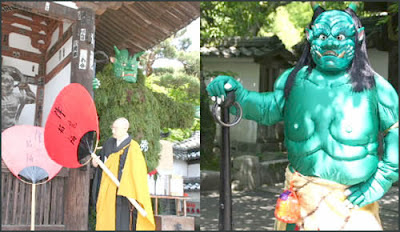:::::::::::::::::::::::::::::::::::::::::::::::::::::::::::::::::::::::::::::::::::::::::::::::::::
Temple Ishiyamadera - "Stone Mountain Temple"
***** Location: Shiga, Japan
***** Season: See below.
***** Category: Humanity
*****************************
Explanation

Autumn at Ishiyama -
by Hasegawa Sadanobu 長谷川貞信 (1809-1879)
The fireflies of Ishiyamadera , Ishiyama botaru
石山蛍(いしやまぼたる)are a
kigo for mid-summer
Ao-oni hotaru matsuri 青鬼蛍祭
Green Demon and Fireflies Festival
Ao-oni matsuri 青鬼祭り festival of the green demon
observance kigo for mid-summer
Second weekend in July.
This festival originated after WWII, in the "Hotarudani" 蛍谷 of the temple compound, in memory of the famous priest of the Heian period, Roochoo ritsushi 朗澄律師.
A demon figure, five meter tall and made of green cedar branches, is displayed at the main gate of temple Ishiyamadera.
This represents the figure of Roochoo, who had promised to protect the Buddhist law from the disturbances of the Green Demon.

.................................................................................
Ishiyama-dera 石山寺
Ishiyamatera, Ishiyama-Tera
Literally "Temple at Rocky Mountain"

© Quoted from : /vallance22.tripod.com
:::::::::::::::::::::::::::::::::::::::::::::::::::::::::::::::::::::::::::::::::::::::::::::::::::
quote
"Stony Mountain Temple" is a Shingon temple in Ōtsu in Japan's Shiga Prefecture. This temple is the thirteenth of the Kansai Kannon Pilgrimage.
It was constructed around 762 CE, and is said to have been founded by Rōben.
The temple contains a number of cultural assets. According to literature available at the temple complex, the guardian carvings at Sanmon/Todaimon are by Tankei and Unkei. Allegedly, Murasaki Shikibu began writing The Tale of Genji at Ishiyama-dera during a full moon night in August 1004. In commemoration, the temple maintains a Genji room featuring a life-size figure of Lady Murasaki and displays a statue in her honor.
© More in the WIKIPEDIA !
:::::::::::::::::::::::::::::::::::::::::::::::::::::::::::::::::::::::::::::::::::::::::::::::::::
Quote
Set on the side of a mountain overlooking Lake Biwa, Ishiyama-dera temple was a popular pilgrimage in Murasaki's day. It was founded in 749 and is headquarters of one of the Shingon Buddhist sects.
The temple is mentioned in the Ukifune chapter of The Tale of Genji and is the 13th temple of the Saigoku Kannon pilgrimage.
Murasaki is said to have begun writing The Tale of Genji at Ishiyamadera Temple on the night of the full moon, August 1004. To commemorate this event, the temple maintains a Genji Room with a life-size figure of the author at work.

The temple's tahoto (treasure tower) was built by Minamoto Yoritomo in the Kamakura period, and is the oldest of its type in Japan.
Ishiyama-dera is particularly beautiful during the cherry-blossom season. The temple's buildings and gardens are spread out over the mountain side.
Look at most beautiful photos here :
© www.taleofgenji.org

"Fire Lamp Window" and Ishiyamadera
火灯窓 Katomado
:::::::::::::::::::::::::::::::::::::::::::::::::::::::::::::::::::::::::::::::::::::::::::::::::::::

The famous rocks, which give the name to this "Stone Mountain Temple", are made from Wollastonite, keikaiseki 硅灰石.
ISHI might be translated as stone, rock.



More LINKS about this temple.
:::::::::::::::::::::::::::::::::::::::::::::::::::::::::::::::::::::::::::::::::::::::::::::::::::
Fudo Myo-O and Ishiyamadera

不動明王坐像

不動明王二童子像
source : takashikun.blogspot.jp
*****************************
Worldwide use
*****************************
Things found on the way
haribukku, haribuku, haributsuku 貼仏供(はりぶっく))
Buddhist offerings pasted on a frame

source : www.ishiyamadera.or.jp
These specially prepared dry sugar sweets (higashi 干菓子) in the form of chrysanthemums, peonies, plum blossoms and other seasonal flowers and auspicious animals like cranes, , which change each spring and autumn.
The special shop which prepares them since the Edo period uses wooden molds more than 200 years old.
The colors are mostly pink, white, yellow, green and blue.
*****************************
HAIKU
Matsuo Basho wrote this famous haiku when he visited the temple in the winter of 1690 and got caught in a hailstorm
石山の石に たばしる あられかな
Ishiyama no ishi ni tabashiru arare kana
霰 arare
scattering on the stones
of Mount Ishiyama -
these hailstones
Tr. Gabi Greve
Here is a memorial stone of this haiku and the real view of these stones:


© 歌碑・句碑 / kahitokuhi
...
A local sweet was later created with some types of sweet beans, using the name "Tabashiru" :

© 石山寺[和菓子と甘味処] 茶丈藤村 sajo-towson
.....................................
Two translation versions by Norman Darlington
hail showers down
on the rocks
of Rocky Mountain
showering down —
hailstones on the stones
of Ishiyama
.....................................
Other translations, compiled by Larry Bole:
The hailstones
Glance off the rocks
Of the Stony Mountain
Tr. Blyth
Hailstones
glancing off the rocks
at Stony Pass.
Tr. Robert Hass
Hass comments:
"Hailstones: Hard things hitting hard things in a hard place.
Mountain passes were mysterious places in old Japanese culture, inhabited by boundary gods and placatory shrines, sometimes with the carved figure of a man and a woman coupling."
flying down
on the stones of Stone Mountain:
hail storm
Tr. David Barnhill
Barnhill's literal translation of "tabashiru" is: "shower-down."
Visiting temples with
. Matsuo Basho 松尾芭蕉 - Archives of the WKD .
......................................
Ishiyama, literally, means "Stone Mountain".
MORE ABOUT
Translating Place names
:::::::::::::::::::::::::::::::::::::::::::::::::::::::::::::::::::::::::::::::::::::::::::::::::::::
Here is another poem of Basho using "stone mountain",
this time from another area of Japan.
石山の石より白し秋の風
ishiyama no ishi yori shiroshi aki no kaze
autumn wind
whiter than the white cliffs
of this stony mountain
Tr. Gabi Greve
Matsuo Basho at Temple Natadera 那谷寺, Northern Japan
Read a discussion of this haiku !
*****************************
Related words
***** The Tale of Genji, Genji Monogatari ... and haiku
***** Sweets from Japan (wagashi)
***** Saijiki of Japanese Ceremonies and Festivals
::::::::::::::::::::::::::::::::::::::::::::::::::::::::::::::::::::::::::::::::::::::::::::::::::






2 comments:
Ishiyama no
ishi yori shiroshi
aki no kaze
Is it possible, that particle "no" plays here a role of particle "ga"?
Gregor
The discussion goes on HERE :
橋桁の忍は月の名残り哉
hashigeta no shinobu wa tsuki no nagori kana
Written on the 13th day of the 9th lunar month 1691. 元禄4年9月13日
Basho was at temple Ishiyamadera 石山寺 with 車要 Shayo and Shido 之道 and left for Edo about 10 days later. So this was a good-bye party of sorts for them.
Maybe he was thinking about the Seta no Karahashi 瀬田の唐橋 Great Bridge of Seta.
MORE
about Seta
Post a Comment